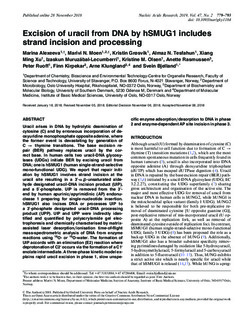| dc.contributor.author | Moen, Marivi Nabong | |
| dc.contributor.author | Grøsvik, Kristin | |
| dc.contributor.author | Kirpekar, Finn | |
| dc.contributor.author | Tesfahun, Almaz Nigatu | |
| dc.contributor.author | Ruoff, Peter | |
| dc.contributor.author | Klungland, Arne | |
| dc.contributor.author | Bjelland, Svein | |
| dc.date.accessioned | 2020-02-07T11:29:55Z | |
| dc.date.available | 2020-02-07T11:29:55Z | |
| dc.date.created | 2020-02-06T10:24:10Z | |
| dc.date.issued | 2018-11 | |
| dc.identifier.citation | Alexeeva, M., Moen, M.N., Grøsvik, K. et al (2018) Excision of uracil from DNA by hSMUG1 includes strand incision and processing. Nucleic Acids Research, 47(2), pp. 779-793. | nb_NO |
| dc.identifier.issn | 0305-1048 | |
| dc.identifier.uri | http://hdl.handle.net/11250/2640375 | |
| dc.description.abstract | Uracil arises in DNA by hydrolytic deamination of cytosine (C) and by erroneous incorporation of deoxyuridine monophosphate opposite adenine, where the former event is devastating by generation of C → thymine transitions. The base excision repair (BER) pathway replaces uracil by the correct base. In human cells two uracil-DNA glycosylases (UDGs) initiate BER by excising uracil from DNA; one is hSMUG1 (human single-strand-selective mono-functional UDG). We report that repair initiation by hSMUG1 involves strand incision at the uracil site resulting in a 3′-α,β-unsaturated aldehyde designated uracil-DNA incision product (UIP), and a 5′-phosphate. UIP is removed from the 3′-end by human apurinic/apyrimidinic (AP) endonuclease 1 preparing for single-nucleotide insertion. hSMUG1 also incises DNA or processes UIP to a 3′-phosphate designated uracil-DNA processing product (UPP). UIP and UPP were indirectly identified and quantified by polyacrylamide gel electrophoresis and chemically characterised by matrix-assisted laser desorption/ionisation time-of-flight mass-spectrometric analysis of DNA from enzyme reactions using 18O- or 16O-water. The formation of UIP accords with an elimination (E2) reaction where deprotonation of C2′ occurs via the formation of a C1′ enolate intermediate. A three-phase kinetic model explains rapid uracil excision in phase 1, slow unspecific enzyme adsorption/desorption to DNA in phase 2 and enzyme-dependent AP site incision in phase 3. | nb_NO |
| dc.language.iso | eng | nb_NO |
| dc.publisher | Oxford University Press | nb_NO |
| dc.rights | Navngivelse-Ikkekommersiell 4.0 Internasjonal | * |
| dc.rights.uri | http://creativecommons.org/licenses/by-nc/4.0/deed.no | * |
| dc.title | Alexeeva, M., Moen, M.N., Grøsvik, K. et al (2018) Excision of uracil from DNA by hSMUG1 includes strand incision and processing. | nb_NO |
| dc.type | Journal article | nb_NO |
| dc.type | Peer reviewed | nb_NO |
| dc.description.version | publishedVersion | nb_NO |
| dc.rights.holder | (C) The Author(s) 2018. | nb_NO |
| dc.subject.nsi | VDP::Mathematics and natural science: 400 | nb_NO |
| dc.subject.nsi | VDP::Medical disciplines: 700 | nb_NO |
| dc.source.pagenumber | 779-793 | nb_NO |
| dc.source.volume | 47 | nb_NO |
| dc.source.journal | Nucleic Acids Research | nb_NO |
| dc.source.issue | 2 | nb_NO |
| dc.identifier.doi | 10.1093/nar/gky1184 | |
| dc.identifier.cristin | 1791504 | |
| cristin.unitcode | 217,6,4,0 | |
| cristin.unitcode | 217,8,10,0 | |
| cristin.unitname | Institutt for barnehagelærerutdanning | |
| cristin.unitname | Institutt for kjemi, biovitenskap og miljøteknologi | |
| cristin.ispublished | true | |
| cristin.fulltext | original | |
| cristin.qualitycode | 2 | |

